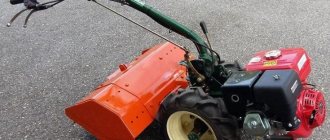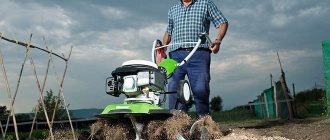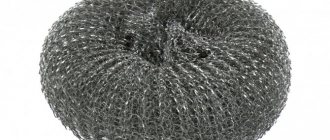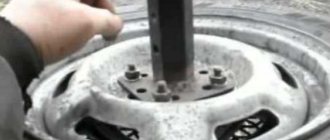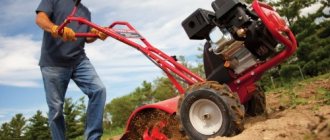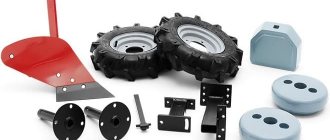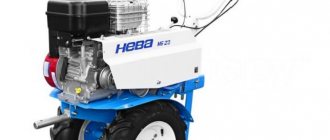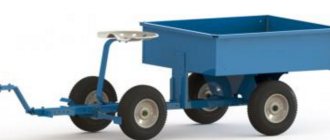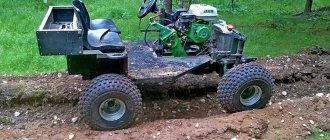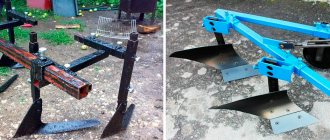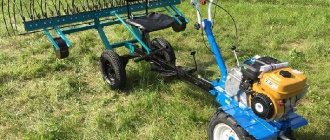A harrow for a walk-behind tractor is an agricultural implement attached to this unit or mini-tractor.
The mechanism is intended for the following purposes:
- loosening, mixing and leveling the soil without turning it over;
- weed removal;
- thinning thickened crops;
- destruction of dry crust on the ground;
- placement of seeds and fertilizers into the soil;
- increasing soil aeration.
The impact on the soil occurs with tools mounted on a common frame, such as:
- teeth;
- hoe;
- disks.
Harrowing with a walk-behind tractor is an important agrotechnical process for cultivating land plots to increase productivity, quality of grain and technical products.
Types of harrows
Harrows for agricultural work are divided into types:
- dental;
- disk;
- rotary.
A tooth harrow is a simple mechanism consisting of a metal frame with teeth of the required length attached to it. The power of the walk-behind tractor affects their number and frame size. The teeth are arranged in a zigzag or rectangular pattern and are attached to the frame rigidly, hingedly or on a spring strut.
The harrowing depth depends on the setting of the teeth. When they are installed with the sharp edge forward in the direction of travel, the depth of loosening increases; when installed backwards, it decreases.
A disc harrow differs from a tooth harrow in that it is a processing tool. Instead of teeth, spherical disks with a smooth or cut cutting edge are attached to the frame and placed at an angle called the angle of attack. It varies and is 10-25°. During the processing process, each disc cuts off the surface layer of the earth, intensively breaks up the roots of weeds, mixes them with the ground and compacts the soil. When carrying out harrowing, agronomists recommend using a needle harrow. The needles penetrate the soil and loosen it.
Disc mechanisms are aggregated with the walk-behind tractor using front or rear suspension.
The rotary harrow is better suited than other mechanisms for initial tillage. The depth of cutting into the ground is 7 cm, but this factor does not prevent it from being used for loosening virgin soil. It resembles a cultivator and a disk device in appearance.
The rotary implement for a walk-behind tractor consists of 6 edges, a disk and a bushing. Its working elements are pointed plates, which are located at different angles.
An active rotary harrow is mounted on shafts instead of wheels or a soil tiller, which greatly increases its productivity, especially on virgin and heavy soils. For high-quality work, it is better to aggregate it to high-power walk-behind tractors with gearboxes.
How to harrow correctly
Each case of using a certain type of equipment is, of course, individual, but there are a number of general rules that should be followed in order to achieve the best results.
- Before starting work, it is necessary to carry out a test run, checking whether the “angle of attack” is sufficient, whether the required depth of entry of the tool into the ground is achieved, whether the degree of crushing of clods of earth at the exit is sufficient.
- When working with a tool, it is always necessary to maintain the sharpness of the “angle of attack”. If it reaches 90 degrees relative to the surface being treated, then the system as a whole will not have enough effort to extract the soil, and it will simply drag the soil in front of it, simultaneously becoming clogged with plant debris and clods of dirt.
- In the case when it is necessary to make different types of furrows on the same field in different rows, then an elongated frame should be used, equipped with different working elements (teeth or disks) coupled with a variety of fastenings (rigid hinged or spring). Then, by loosening/tensioning the fasteners, different types of furrows can be achieved on the same field.
- You should constantly ensure that the teeth, disc recesses, and rays of the rotor stars do not become completely clogged. If such a situation is detected, they must be cleaned immediately. This way you can significantly extend the service life.
- It is important to ensure that the furrows left by the working bodies are uniform in those places where this is necessary (the exception is the case of using different working bodies on the same frame).
- The depth of the furrows can also be increased by increasing the weight of the walk-behind tractor itself.
Other nuances and wisdom are achieved through practice and experience.
DIY tooth harrow
A homemade tooth harrow for a walk-behind tractor differs from a factory one in the quality of the material from which it is made. The factory model is made of structural steel that can withstand large and intense loads. Let's look at how to make your own harrow with the same properties.
A do-it-yourself tooth harrow for a walk-behind tractor can be made by any craftsman. This process is not difficult. The design is simple and does not have complex connections.
First, you need to design a harrow on a walk-behind tractor with your own hands with drawings that give an idea of the dimensions, connections and general layout.
The tool is made of steel strip, square pipe or angle.
The algorithm for manufacturing a dental device is as follows:
- Metal strips at an angle of 30° to each other are welded to the pipe from the bottom side. The edges should protrude evenly on both sides.
- A sleeve is installed in the middle by welding. Using a finger, the harrow is connected to the walk-behind tractor through the bushing. The lifting height should be adjusted by the stand for the depth of loosening.
- Teeth are installed on each edge of the steel strip using bolts or welding.
- A drawbar is mounted on the bushing.
- A screw is attached to the drawbar to adjust the position of the teeth. The front and rear tines should sink equally into the soil.
Experts recommend making the working elements of the harrow from hardened steel. It is better to make the teeth from corrugated reinforcing steel with a diameter of 10-14 mm and a length of 10-20 cm. The longer the teeth, the thicker they should be. They must be sharpened and hardened before attaching them to the frame, otherwise they will bend.
A do-it-yourself tooth harrow for a walk-behind tractor is an excellent helper for small farmers and summer residents cultivating their plots.
Assembly
The assembly process is the final step. The implementation of the step begins as soon as the model has been made and all the necessary parts have been made. The first step is the production of the lattice. Next, teeth are attached to it at an angle of 90 degrees. Hardened teeth do not change their quality of strength.
The next step is to determine the center of application of forces. And the chain is welded to the selected center.
Take the very first element and place it on the grid and weld it. Then the next one. Grab or attach with hardware. The quality of work is checked after complete attachment. If the need arises, the chain is digested.
DIY disc harrow
The disc implement is a more advanced model that performs more functions for cultivating the land. The design is more complex, so it is better to buy a ready-made device on the industrial market. But for those who are not afraid of work, you can make a disc harrow yourself.
The manufacturing work comes down to the following:
- For production, disks and 2 pipes are required with mandatory reliable fixation on the walk-behind tractor shaft. The total length of the pipes should not exceed 1 m. Discs are selected with a diameter of up to 20 cm.
- Using a grinder, cuts are made on the discs at a distance of 10 cm from each other around the circumference; in the center there are mounting holes for further installation on the shaft.
- The finished disks are installed on the shafts every 5-8 cm with an inclination to the shaft axis: on the left side - in one direction, on the right - in the other.
Making a harrow for a walk-behind tractor with your own hands is not difficult, but this requires well-designed drawings, diagrams, tools and materials. The choice of device depends on the capabilities of the master and the purposes for using the mechanism.
Difficulty of choice
The choice of equipment should directly depend on the engine power of the walk-behind tractor: for rotary engines you will need a more powerful power unit, for toothed ones - a weaker one. The same can be said about the complexity of the work - for less pliable soil overgrown with turf, a professional, expensive rotary is suitable, and a light household toothed one can handle a small dacha plot.
However, it may well happen that the tool will cost more than the walk-behind tractor itself. First of all, this concerns frames with various working bodies and rotary models, especially high-precision sharpening.
It is worth noting that equipment manufactured in foreign countries is not necessarily 100% high quality. On the contrary, the agricultural countries of the CIS (Ukraine, Belarus, Kazakhstan) have long become leaders in this market, which provide products that have an excellent price/quality ratio.
Do-it-yourself active rotors for a walk-behind tractor
A rotary harrow is a more complex design compared to a tooth or disk harrow. This device is used for aerating and loosening the soil after harvesting, as well as for removing weeds and plowing to a depth of 10 cm.
Active rotors can be created from available materials, and the first thing you need for work is to find drawings and dimensions. The length of the rotor can be from 70 to 100 cm, the diameter can be any, the main thing is that it is combined with the dimensions of the walk-behind tractor.
In general, the design of a rotary harrow consists of several disks with blades on an axis or a pipe with blades, which should not be located perpendicularly, but at a slight angle to the surface. The simplest option is shown in the photo:
A more complex harrow, the design of which is similar to the factory one, can be made from a gas cylinder. Step by step instructions in this video:
Active rotors are installed instead of wheels or lugs, however, depending on the design of the walk-behind tractor, the equipment can be mounted at the front as a hinged one. Therefore, it is important to take into account the design of the walk-behind tractor itself when designing a harrow.
Features and Benefits
What is a diskator? This is a disc harrow, where a separate mounting post is used for each cutting element.
This design allows you to completely eliminate clogging of the cutting discs, which has a positive effect on labor productivity.
In addition, discators show good performance in conditions of high humidity and dense vegetation. The main purpose of this type of agricultural equipment is to prepare the land for sowing without prior plowing.
It is worth noting that individual fastening of discs allows for better control of weeds by mixing the soil with plant residues. However, these are not the only advantages of PM.
Diskators can perform the following operations:
- Prepare the soil for planting all varieties of agricultural crops, including industrial and fodder.
- Preparation of small-contour areas and fields with complex geometry.
- Peeling stubble and forming a mulch layer.
- Preparation for planting of turfed areas of the field and land allocated for pastures and meadows.
It is worth noting that in one pass across the field, the disker performs several operations at once: it crushes the soil, levels the surface and mixes the soil with weed residues.
Moreover, each of the installed disks has individual adjustment, allowing you to smoothly change the processing width or angle of attack.
Thanks to their versatility, diskers help save up to 12 liters of diesel fuel per hectare processed. Accordingly, this type of agricultural equipment pays for itself already in the second season of operation.
Diskators also have design flaws. For example: a rigid mounting option for a strut often leads to mechanical damage to the hub.
To avoid breakdowns, the bearing must be lubricated regularly, which requires additional maintenance time.
It is typical that such problems occur only in Russian-made disk drives. Imported models use a spring-loaded rack mounting system.
Harrow for walk-behind tractor Neva
Neva walk-behind tractors are among the highest quality and most in demand on the domestic market. There is a wide range of attachments for them, which can be purchased from the manufacturer or made by yourself. Thanks to the universal H-hitch, coupling with attachments is easy.
Any type of harrow is suitable for the Neva walk-behind tractor; it all depends on the purpose of creating the equipment, as well as the resources spent. Any of the types can be made using improvised means. To assemble a homemade harrow with a walk-behind tractor, you need a high-quality hitch, which you can also make yourself.
Rotary hoe drawing
The design of a classic rotary harrow-hoe can be seen using the example of the Sarmat MRN model (Figure 1 and Figure 2). It is quite difficult to reproduce such a device on your own. You can only install its simplest version with low performance.
Figure 1. General diagram
Figure 2. Design of scratch disks
Rotary harrows-hoes replace a whole set of agricultural machinery, providing high-quality soil care at a high level of productivity. Domestic manufacturers (“Agrotekhnika”, Volzhsky, “Agro-partner”, Engels, “Tekhmash”, Shakhty) offer a large selection of models for processing small and extensive farmland.
Harrow for MTZ walk-behind tractor
Any type of harrow is suitable for the MTZ walk-behind tractor, but it is important to take into account that the types of their attachment are different, for example, a rotary harrow is attached instead of wheels, a disc harrow is attached as an attachment, but is of the active type, so its design must have an additional shaft for power take-off.
The simplest type of harrow to implement is the tooth harrow, since no additional mechanisms are needed to assemble it with a walk-behind tractor. When creating such a harrow with your own hands, you must first create drawings, think over the dimensions (working width), and type of fastening. MTZ walk-behind tractors are equipped with a universal H-shaped hitch, so the bracket for attaching the harrow must be combined with it. You can make a rigid mount consisting of a bracket with a handle, but a more affordable option would be to mount it using a chain. To do this, it is necessary to create a bracket with a frame corresponding to the width of the harrow on which the chains will be attached (they can be welded or attached to hooks).
What type of walk-behind harrow did you use?
Rating of the best harrowing tools in 2022
5th place: Drag harrow for Neva and Salyut walk-behind tractors (station wagon)
An easy-to-use drag harrow with a chain attachment. Does not require labor-intensive cleaning after work. The fastening feature provides for some freedom of maneuver when harrowing (for example, ease of rotation).
Specifications:
| Name | Index |
| Width grip, cm | 40 |
| Manufacturer | Forza |
| Processing depth, cm | 15 |
| Weight, kg | 15 |
| Fastening | Chain (drag) |
| Price, rub. | 3850 |
Drag harrow for Neva and Salyut walk-behind tractors (station wagon)
Advantages
- Increased coverage across processing width;
- Simple fastening;
- Relatively affordable price.
Flaws
- Excessive weight (requires preliminary loosening of the soil)
4th place: Dental for Mobil K BM-0.9 walk-behind tractor
This tool is ideal for all models of walk-behind tractors produced in the CIS and can be used on more than 20 model variants. Light weight greatly facilitates the work process. Can be used even on dry soil.
Specifications:
| Name | Index |
| Width grip, cm | 90 |
| Manufacturer | Mobile K (Belarus) |
| Weight, kg | 6 |
| Additionally | Station wagon |
| Price, rub. | 3400 |
Dental for Mobil K BM-0.9 walk-behind tractor
Advantages
- Reduced weight;
- Universality for walk-behind tractors produced in the CIS;
- Simplicity of design.
Flaws
- Extremely wide grip width (requires extremely slow processing speed)
3rd place: teeth B-5 for Belarus MTZ 09N, 012WM walk-behind tractors
The universal canopy is suitable for both domestic and imported walk-behind tractors. It belongs to the category of light tools and is intended for performing work of minor complexity on a summer cottage or personal plot. Easy to install and does not require special cleaning procedures.
Specifications:
| Name | Index |
| Dimensions in open position (LxWxH), mm | 550x1770x650 |
| Working width, mm | 970-1670 |
| Max. processing depth, mm | 120 |
| Weight, kg | 10.5 |
| price, rub. | 3800 |
teeth harrow B-5 for Belarus MTZ 09N, 012WM walk-behind tractors
Advantages
- Versatility;
- Easy to use;
- Reliability of the design.
Flaws
- Small processing depth.
2nd place: Disk database 850M Neva
The tool is designed for loosening and preparing soil for sowing in difficult conditions. It is capable of perfectly destroying weeds and crushing rotten remains. Pre-sowing preparation with its help can be carried out even without preliminary plowing and harvesting of row crops with thick stems.
Specifications:
| Name | Index |
| Adjustable working width, mm | 700-800 |
| Adjustment of the “angle of attack” of the disks, degrees | 10,15, 20 |
| Axes of rotation | with Teflon bearings |
| Additionally | 8 discs 300 mm with sharpening |
| price, rub. | 12000 |
Disc harrow BD 850M Neva
Advantages
- Adjustable width and “angle of attack”;
- Relative lightness of construction;
- The coupling is performed with one locking action without metalworking tools.
Flaws
- The need to install lugs instead of wheels on the walk-behind tractor.
1st place: Rotornaya Neva RB3
Designed for pre-sowing and post-harvest tillage. It is also capable of plowing green manure in the fall. The ergonomic design easily cuts dried layers of earth, and the stars following the main ones loosen this cutting. Produces the most even soil tillage.
Specifications:
| Name | Index |
| Weight, kg | 20 |
| Sleeve dimensions, mm | 30.2x80 |
| Dimensions of the device itself | 320x700 |
| Maximum processing depth, mm | 200 |
| Price, rub. | 14000 |
Rotary harrow Neva RB3
Advantages
- Increased tillage depth;
- 8 powerful cutting 6-pointed star plates;
- Ability to work with hard soil types.
Flaws
- The sections must be installed on the gearbox shafts of the walk-behind tractor.
Instructions for use
Each harrow purchased comes with instructions for its operation. But if you built it yourself, here are the basic rules:
- how to use a harrow;
- safety precautions when handling the unit
- harrow maintenance.
The harrow is used only for field work. Using it for other purposes may cause a breakdown and the manufacturer declines all responsibility, and a broken unit is not subject to guaranteed service.
- Choose spare parts carefully, only from trusted companies. The use of non-original parts may result in damage to other parts of the harrow.
- Only adults with technical education and training should operate and maintain the harrow. Otherwise, improper use of the device may result in personal injury.
- Before you start working with the harrow check all the components so that nothing is loose. The required parts of the structure are well lubricated. Connecting parts, especially threads on the mount with a walk-behind tractor or walk-behind tractor.
- Do not work with doors open to avoid inhaling dust or damaging your eyes, especially in dry areas. The permissible distance from a working machine is 20 meters, for safety reasons.
- If the permissible distance is reduced, the tractor driver is obliged to stop the machine to prevent accidents. Carefully observe the operation of the harrow; if you suddenly hear extraneous noises, stop and check if everything is in order.
- And then suddenly the tractor-harrow mount breaks and someone gets hurt.
- Do not recycle the unit to avoid increasing the risk of breakage. Do not exceed the permissible operating speed to avoid unscheduled repair work.
- When repairing or performing maintenance on the device, be extremely careful. A very important part of the device is the hydraulic system; carefully monitor the oil level in it and avoid leaks.
- It is necessary to move the harrow to the actual work site only with the help of a tractor with a load capacity of more than 6500 kg. If you feel unwell while working with equipment, stop working to avoid an accident.
- When assembling the future unit, pay special attention to the components containing mounting bolts. Move the rotating parts carefully to avoid cutting off your finger. Tighten the bolts, nuts and other connecting parts thoroughly before checking the operation of the harrow.
- If the bolts are poorly secured, then there is a danger of losing the disks during operation of the device.
- When checking sharp parts of the harrow, wear protective gloves to avoid injury. Pay special attention to checking the hydraulics of the unit.

